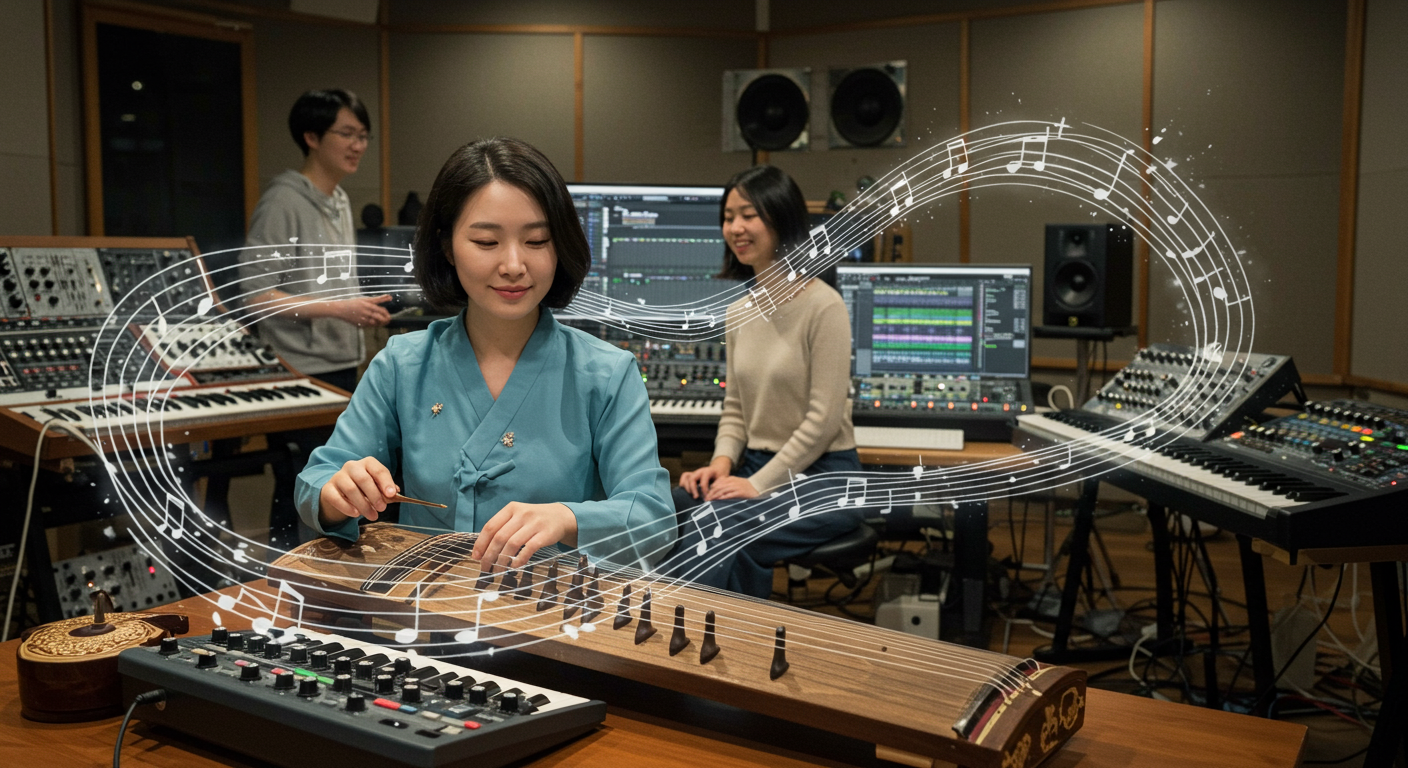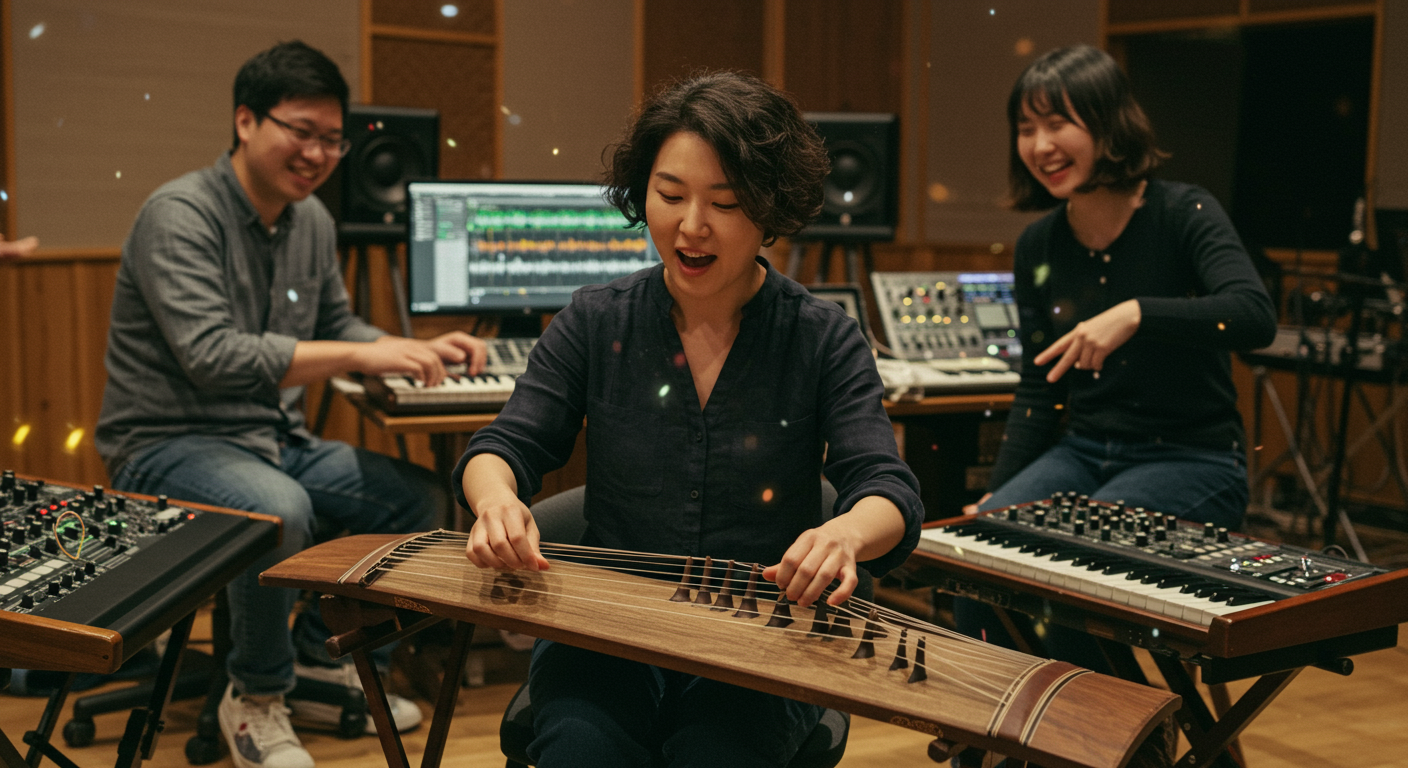Yoo Ka Youn: Weaving Korean Soul into Global Soundscapes
Yoo Ka Youn: Weaving Korean Soul into Global Soundscapes
Have you ever heard a melody that feels ancient yet utterly new, deeply rooted yet soaring freely across borders?
I've always been fascinated by artists who can bridge worlds, you know? It’s not easy to take something so traditional and make it speak to a global audience today. But then there’s someone like Yoo Ka Youn, a composer and music producer who is absolutely mastering this art. She takes the beautiful, soulful essence of Korean sounds and blends them with contemporary music in a way that just… captivates you. It’s truly a special talent, and I wanted to dive into what makes her work so compelling and how she’s shaping the future of K-music.
Table of Contents
 Description: "A vibrant, artistic illustration of composer Yoo Ka Youn in a studio, surrounded by traditional Korean instruments like a gayageum and modern music production equipment, with swirling musical notes depicting a fusion of sounds. She is in her late 30s to early 40s, focused and passionate."
Description: "A vibrant, artistic illustration of composer Yoo Ka Youn in a studio, surrounded by traditional Korean instruments like a gayageum and modern music production equipment, with swirling musical notes depicting a fusion of sounds. She is in her late 30s to early 40s, focused and passionate."
The Harmonious Blend: Where Ancient Echoes Meet Modern Rhythms
What truly sets Yoo Ka Youn apart, I think, is her incredible ability to fuse the soul of traditional Korean sounds with the innovation of contemporary music. It’s not just about throwing a *gayageum* over a beat; it's about understanding the deep cultural roots of each melody, each rhythm, and then finding its modern counterpart. She makes music that feels timeless, somehow. Like, you can hear centuries of history in one note, but then it transitions into something entirely fresh, something you’d hear on a cutting-edge playlist.
I remember the first time I heard one of her pieces – it was a moment of pure realization. The way she layers the intricate lines of traditional string instruments with modern synths creates this lush, expansive soundscape that pulls you right in. It’s almost like she’s telling a story through different eras, all at once. Her compositions evoke a strong sense of place and identity, yet they're universally understood. That's the magic, isn't it? Bridging cultural gaps through pure sound.
 Description: "A close-up, high-quality photo of a young woman's hands gently plucking the strings of a gayageum, with a blurred background of modern synthesizers and computer screens in a dimly lit, creative studio setting. The atmosphere is serene yet innovative."
Description: "A close-up, high-quality photo of a young woman's hands gently plucking the strings of a gayageum, with a blurred background of modern synthesizers and computer screens in a dimly lit, creative studio setting. The atmosphere is serene yet innovative."
Yoo Ka Youn's Global Footprint: A Journey of Musical Innovation
Her talent hasn't gone unnoticed, of course. Yoo Ka Youn has truly become an ambassador for Korean music fusion on the world stage. She's performed her works at various prestigious venues, bringing her unique sound to diverse audiences. Honestly, it's inspiring to see how she takes something so deeply personal and culturally specific, and then finds a way for it to resonate globally. It's not just about performance; it's about sharing a part of Korea's rich musical heritage in a way that feels relevant and exciting to everyone.
Her journey is a testament to the power of artistic vision. From what I've gathered, she's not just a composer but a true innovator, constantly pushing boundaries and exploring new avenues for expression. She's definitely one of those artists who make you think, "What will she do next?" That curiosity, that excitement – it’s what keeps her audience coming back for more.
Here's a quick look at some elements that characterize her innovative work and performances:
| Key Characteristic | Description | Example/Impact |
|---|---|---|
| Traditional Instrument Mastery | Deep understanding and innovative application of Korean traditional instruments. | Blends *gayageum* or *haegeum* with electronic soundscapes. |
| Cross-Genre Fusion | Seamless integration of classical, jazz, electronic, and folk elements. | Creates a unique "K-music" identity for a global audience. |
| Emotional Storytelling | Compositions often convey narratives or evoke specific emotions. | Her music resonates deeply, transcending language barriers. |
 Description: "A dynamic concert photo of Yoo Ka Youn on stage, conducting or performing with a fusion ensemble. The stage lighting is dramatic with purple and blue hues, and the audience is a blur in the background, showing her captivating presence."
Description: "A dynamic concert photo of Yoo Ka Youn on stage, conducting or performing with a fusion ensemble. The stage lighting is dramatic with purple and blue hues, and the audience is a blur in the background, showing her captivating presence."
Unpacking Her Art: The Craft Behind the Korean-Contemporary Fusion
So, how does she do it? It's not just random blending; there's a definite method to her beautiful madness, if you ask me. Her creative process seems to involve a deep respect for tradition, coupled with a fearless desire to experiment. It reminds me that true artistry is often found at the intersection of reverence and rebellion.
I imagine it's a meticulous process, where she might spend hours researching ancient scores or field recordings, and then shift to manipulating sound design on a computer. That kind of dedication, really, is what separates a good artist from a great one. She's not just making music; she's crafting experiences.
Based on my understanding of her work and the broader field of music production and global soundscapes, here are some key aspects that likely define Yoo Ka Youn's compositional approach:
- Deep Dive into Traditional Korean Melodies: This isn't just surface-level. She studies the nuances, the scales, the philosophical underpinnings of traditional Korean music before anything else. This gives her compositions an authentic core.
- Experimentation with Modern Instrumentation: Once she understands the traditional essence, she introduces modern elements – synthesizers, electronic beats, contemporary orchestral arrangements – always with a mind to complement, not overshadow, the original spirit.
- Emotional Layering and Storytelling: Her music isn't just technically brilliant; it's emotionally resonant. She weaves narratives, often drawing on Korean history or personal experiences, into the fabric of her sound, allowing listeners to connect on a deeper level.
- Global Collaboration and Interpretation: She actively seeks to understand how different cultures perceive sound and rhythm, collaborating with international artists to create pieces that speak a universal musical language while maintaining their distinct Korean flavor.
Ultimately, Yoo Ka Youn is more than just a composer or producer; she's a visionary helping define what K-music means in the 21st century. Her dedication to blending heritage with innovation is truly something to behold. I can't wait to see what new sonic adventures she takes us on next!
 Description: "A candid, warm-toned photograph of Yoo Ka Youn smiling and engaging with a small group of diverse music students or fans after a workshop, in a bright, modern cultural center. The setting suggests mentorship and inspiration."
Description: "A candid, warm-toned photograph of Yoo Ka Youn smiling and engaging with a small group of diverse music students or fans after a workshop, in a bright, modern cultural center. The setting suggests mentorship and inspiration."
Q&A: Diving Deeper into Yoo Ka Youn's World
It means integrating elements like traditional Korean instruments (e.g., *gayageum*, *haegeum*, *daegeum*), specific vocal techniques (*pansori* influences), and traditional melodic or rhythmic patterns (*gugak*) into modern musical compositions that might include electronic beats, Western orchestral arrangements, or contemporary pop structures. It's about creating a dialogue between the old and the new, keeping the essence of the traditional while making it accessible and appealing to a modern, global audience.
From what I understand, her authenticity comes from a deep respect and study of traditional Korean music. It's not just a superficial overlay. She understands the historical, cultural, and emotional context of these sounds. This deep knowledge allows her to weave traditional elements into contemporary frameworks in a meaningful way, creating something that honors its roots while evolving. Her compositions often tell stories or evoke genuine emotions, which further grounds them in authenticity.
Her work is crucial in broadening the scope of what "K-music" means to the world. While K-pop has undeniably opened many doors, artists like Yoo Ka Youn introduce a more diverse, nuanced, and historically rich aspect of Korean musical heritage. She demonstrates that Korean music is far more than just pop; it has profound traditional roots that can be incredibly innovative and captivating when presented in a contemporary context. This helps to cultivate a deeper appreciation for Korean culture as a whole, showcasing its artistic depth and versatility.
While the provided summary doesn't specify particular instruments, a common practice in Korean fusion music involves instruments like the gayageum (a zither-like string instrument), the haegeum (a two-stringed fiddle), and various percussion instruments. These instruments offer unique timbres and melodic capabilities that are distinctively Korean and lend themselves beautifully to fusion. It's very likely she employs a range of these, chosen for their ability to blend harmoniously or offer striking contrasts with modern sounds.
Comments
Post a Comment